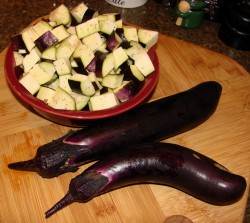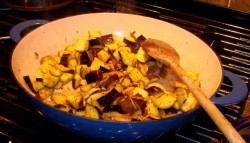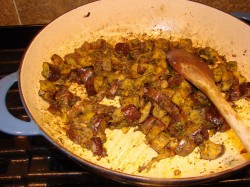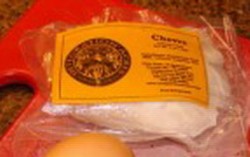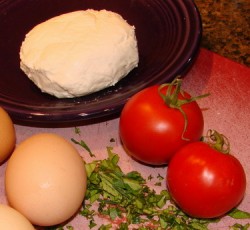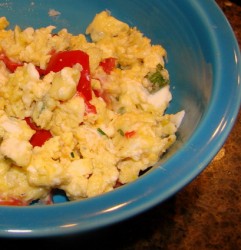Is Cooking For Your Family “Retrograde June Cleaver Nonsense?”
So, I was reading Slashfood today, and came upon this post highlighting an article in the New York Times written by a working mom who has made the choice to cook healthy dinners for her family almost every night.
In “Mom Puts Family on a Meal Plan”, author Leslie Kauffman relates how she, as a working mother of two boys, decided that cooking for her family was important. This is how she puts it: “I committed to cooking a family meal when my first son was born, in 1997, not because of any psychology study about the well-being of children, but because it gave me comfort. Every working mother has to draw the line somewhere. Maybe my children would take their first steps with a babysitter, or perform in school plays with only their grandparents in attendance. But mom would cook their dinners.”
She then goes on to give details of her personal strategy for putting home-cooked dinners on the table at least five nights a week, which boils down to simplicity, organization, discipline and planning ahead. Her techniques are sound, and if you are a time-strapped parent, student, bachelor or workaholic, Kauffman’s tips will help you get off the takeout train and hop into the kitchen for some good, old-fashioned real home cooking.
So, I read the Slashfood post, clicked over and read the article, and thought, “Well, that is a nice little article there, very helpful and supportive to the working parents of the world, and full of useful information. Wow. Cool.”
Then, I went back to Slashfood and saw that the post had seven comments on it. The second one hit me in the stomach like a strong left hook. The author of the comment, who signed as MK, said, “I can’t possibly understand why Slashfood would choose to highlight this retrograde June Cleaver nonsense. It’s also hard to believe the NYTimes published it. Thanks for the ‘tips’ but no thanks.”
At first, I thought, well, maybe the poster was just having one of those days when crankiness is next to godliness, and had to spout off at something, and well, maybe she or he hates cooking.
Then, I reread it and felt that the theme that delineated the brief comment is one that has always bothered me, and that is the idea that a woman cooking for her family is somehow outdated, unfeminist and anti-woman. It is somehow politically incorrect for a mother to want to cook for her family.
This opinion makes no sense to me. For one thing, it seems to be stating that because women in the past were societally expected to cook dinner for their families whether they wanted to or not, even if they worked outside the home, that women cannot possibly choose to do so now that societal pressure is no longer on them. The assumption behind this sort of belief is that if a woman chooses to cook for her children, she is making that decision not for herself, but instead is making a sacrifice of herself because those mostly defunct social mores dictating the behavior of women are still lurking in her brain, waiting to turn her into a Stepford-wife-like slave to her family.
Please look carefully at the author’s own words. She said, “I committed to cooking a family meal when my first son was born, in 1997, not because of any psychology study about the well-being of children, but because it gave me comfort.”
In other words, she did it for her own sense of self and well-being.
How exactly is that unfeminist and anti-woman?
I was under the impression that the point of feminism was to give women opportunities and choices. Feminism is nothing more than the idea that women are completely human, and deserve the same rights and responsibilities that men enjoy in society, and that the same choices that apply to men should also apply to women. I thought that the women’s movement was aimed at creating a society where women would be able to exercise the same choices in self-determination that men could. Feminism is about ending proscriptive sexually-defined social roles and opening up economic and career opportunities for women.
In other words, feminism is about making it equally acceptable for mothers and fathers to be the primary caretakers for their children, no matter what other people may think about that arrangement.
My guess is that if the article had been written by a working dad who decided to cook all of the meals for his family, there would never have been a comment about “retrograde Uncle Charley (from “My Three Sons”) nonsense.” If a man chooses to go against old sexual stereotypes, there are certain feminists who will applaud that decision; however, those same feminists will get all het up if a woman chooses to go with a sexual stereotype, and will insult her decision.
Tell me, how is it feminist to insult the decision another woman has made, based upon her own desires and comfort level?
And, while you are at it, what advice would you give busy working women or men cooking for their families who want to serve nutritious meals, but who cannot spend hours in the kitchen?
Baigan Methi
I may not like summer heat, being as I tend to wilt when temperatures soar above eighty degrees, but I sure love summer.
Why?
Because of all the delicious locally grown produce, of course.
Especially heat lovers like eggplant, known in Hindi as baigan.
Look at those gorgeous little Asian eggplants up there: shiny dark violet skins enrobing spongy greenish flesh with very few seeds and absolutely no bitter juices. I love them. They are luscious to look at and luxurious to eat, so rich, so sweet and so easy to cook. You just cut them and go–with the smaller eggplant varieties, there is absolutely no need to salt them and squeeze out the bitter tears that weep out of them. There is no waiting. They are nearly instant food.
I am going to tell you–I love eggplants cooked any way they can be cooked. I like them in Mediterranean recipes such as rich pasta sauces and moussaka, and I love them in Middle Eastern classics like baba ganoush. And I like them cooked in Thai curries, too. And I like them in Chinese stir fries and braised dishes, even if I haven’t written about those recipes yet.
But my absolute favorite ways with lush sexy aubergines are the recipes from the varied kitchens of India. Oh, how I love baigan bartha, rich with tomatoes, onions, garlic and spices. I also adore the little ones stuffed with a mixture of shredded vegetables, keema sookh and rice, then steam baked, and served with raita or a mango chutney on top.
When I bought these little lovelies at the farmer’s market, I intended to cook them southern Indian style, with a tempering or tarka of chilies, mustard seeds, cumin and curry leaves.
Alas, however, I was sad to find that I had used the last of the curry leaves in my freezer and had forgotten to replenish my supply. Woe!
Necessity, however, is the mother of invention. What I lacked in curry leaves, I made up for in the bunch of fresh methi I had just bought from the farmer’s market. Methi is the greens of the fenugreek plant which gives us fenugreek seeds, an important spice in Indian cookery. The leaves have a very musky, somewhat bitter flavor that also has a sweet, hay-like fragrance.
I had been planning on aloo methi, but taking a long sniff of the fragrant leguminous leaves, I decided that the bitter-sweet flavor of the fresh greens would be just as good as curry leaves with the eggplant–just different.
So, instead of using an established recipe, I went with my own initiative and worked out a recipe myself. I used mustard oil, onions, a wee bit of garlic (garlic and eggplant go together like Ginger Rogers and Fred Astaire in my kitchen–they dance together on the tongue with light and airy steps, leaving behind joy) chili and ginger, and a sprinkling of cumin, mustard seeds and methi seeds. Salt, the methi greens, and of course, a tiny bit of water, made up the rest of the ingredient list, and so, I began cooking.
I cooked it all simply, over high heat, browning the onions deeply first, then adding the whole spices, the garlic, ginger and chili. When these ingredients took on color and fragrance and the mustard seeds popped, in went the eggplant, which I stirred like mad. I added a tiny bit more oil, as eggplant will soak up oil like a sponge, and then I turned the heat down slightly and let the eggplant begin to brown. As it shrank and browned, I threw in the finely minced fresh methi, and sprinkled about a quarter cup of water over it all.
The water simmered away, and then I started to stir, letting the methi leaves cook down and release most of their liquid, and get a tiny bit crispy in places.
With a sprinkle of salt to taste, it was all done: a fragrant medley of flavors, spicy, sweet, musky and hot all at once.
Morganna loved it, and she and I pretty much finished up the entire pan of it last night, with a bit of help from Kat, who also appreciated the complex flavors of the dish. A little tiny bit was left over that I am going to grind up today into a thick puree and freeze in small cubes to use as food for Kat’s lunches and dinners when we are eating things which are not really good for yet, like eggs, curries with nuts and other such baby-unsafe dinners.
Ingredients:
4-6 tablespoons mustard or canola oil (mustard oil gives incomparable flavor and fragrance, if you like it)
1 cup of thinly sliced yellow onions
1 teaspoon salt
1/2 tablespoon minced fresh ginger
1 1/2 tablespoons minced fresh garlic (about three large cloves)
1 fresh green cayenne pepper, thinly sliced (or to taste)
1 teaspoon mustard seeds
1 teaspoon cumin seeds
1/4 teaspoon methi (fenugreek) seeds
1 pound of small Asian eggplants, stalk trimmed off and cut into 1/2″ dice
1 cup moderately packed methi leaves (large stalks removed), finely minced
about 1/4 cup water
salt to taste as needed
Method:
Heat the smaller amount of oil in a heavy-bottomed skillet. (Cast iron is great for this.) Add the onion, and sprinkle with salt. Cook, stirring, on medium high heat, until the onion is a medium golden brown. Add the ginger, garlic, cayenne, and spice seeds. Cook , stirring, until the onions are a deeper brown, the garlic and ginger have taken on color and the mustard seeds have popped.
Add in the eggplant, and cook, stirring, until the eggplant just begin to brown. If you need to, add a little bit more oil at this point.
When the eggplants have softened and are browned on all sides, add the methi leaves and sprinkle the water over all. Turn the heat down and allow the methi leaves to wilt. Then stir, cooking off all of the water, until some of the leaves brown a bit and crisp slightly.
Taste for seasoning, and add salt as needed.
Serve with rice, raita and dal for a complete meal, or stuff into chapati for a snack.
Farmer’s Market Find, Part II: Local Chevre
I love having the gift of being able to sense the new goodies at the farmer’s market here in Athens. I really do. It is almost a sixth sense–an ability to ferret out the newest local foods that our farmers and food producers have brought to market, so that I can bring them home to my family and friends.
When I was at the market last Saturday, I found something truly spectacular.
Freshly made local goat cheese.
Oh, raptures and joy! I was wandering along and saw something that looked rather like a small flattened ball of chevre off out of the corner of my eye, and like a hound on the scent, I veered off to the left and found myself at the table of Chris Chmiel, founder of Integration Acres, the largest commercial producer of pawpaw products in the world. (Okay, I will talk about the pawpaw thing in a later post. I promise. Right now, however, I want to talk about cheese, so be patient. I will get around to it.)
Chmiel uses goats to help tend his forest pawpaw patches. The pawpaw trees are not eaten by the browsing goats because their leaves and bark contain a chemical which makes it unpalatable to any grazing animal; thus, the goats eat the underbrush and other small trees and shrubs which compete for nutrients and water with the pawpaw trees without harming the trees themselves. In return, the goats give fresh milk which Chmiel has just started turning into fresh farmstead cheese this summer.
In fact, he told me when I popped up in front of his table with a hungry grin, asking rather cheerily, “Is that really fresh, local chevre?” that it not only was what I thought it was, it was the first day he had sold it to the public.
I was suddenly very happy to be part of the public.
Before he could even give me a free sample, I had already told him I wanted to buy some. I could smell it, and it smelled briny and sweet and tangy and wonderful from where I stood. I couldn’t want to combine it with some of my anise-scented basil and ripe tomatoes to make–oh, I didn’t really care what I made out of it, so long as it was good.
As Chmiel said, this is probably the freshest cheese I have ever tasted, outside of the paneer I have made myself in the past. But even so, his milk probably started out fresher, so I think his chevre still beats out my paneer for freshness.
It is certainly fresh, and delicious–as good, or better–than it smells. It is tangy, salty, sweet and milky, all at once. It is rich, too–with a full, creamy texture and a fluffy mouthfeel. Some chevre can be chalky and heavy, but not his. It is amazingly good–the best chevre I have ever eaten, bar none. And I don’t say that lightly, as I adore chevre, and have eaten a lot of it, from all over the place, for years.
What have I done with it so far?
Well, I have further plans for it, but for the moment, I have kept it simple. I spread some on thin slices of flaxen whole wheat bread from the Village Bakery down the hill from our house, then sprinkled it with minced basil and topped it with paper-thin slices of ripe tomato. That was a wonderful little meal yesterday for Morganna, Kat and I.
And this morning, I made a thoroughly local breakfast out of Bridlewood Acres pastured eggs scrambled with my own minced chives, parsley and basil, with sliced ripe tomatoes from Shade River Farm and Integration Acres chevre folded in. I didn’t even need to add salt it was all so good. With a bit of toasted flaxen bread with local butter on it, and some good coffee, I was in heaven.
And so was Kat. She could eat me out of house and home on goat cheese, basil, bread and tomatoes. I left out the eggs for her, though, because I want to keep her away from egg whites until she is a year old.
But after that–well, we’ll see what she thinks of Mamma’s Tomato-Chevre Basil Scramble then.
(Okay, I am not posting a real recipe here. I figure you all know how to scramble eggs, so follow your usual procedures, but use less milk or cream than usual, and beat in a handful of minced herbs. Then cook your pastured, super-fresh eggs in a bit of melted local butter, and when they are nearly done, fold in however much chopped tomatoes and crumbled goat cheese you want. When the tomatoes wilt a bit and the goat cheese melts and the eggs are done to your liking, scoop everything out of the pan into your bowl or plate and eat. And smile, because your tongue and tummy will be happy. I promise.)
Seekh Kebab: Punjabi Comfort Food
Eating Indian food out can be a wonderful experience; it can also be an experience filled with frustration.
Much of my problem with eating Indian food out is that when we lived in Maryland, I became used to eating at a truly excellent Indian restaurant where the food was consistently excellent. In fact, the way I learned to cook the food of Northern India was by analyzing the flavors of the food at Akbar, and then studying Indian cookbooks, and practicing replicating the flavors at home. Over the years, I have gotten better and better at making the foods of northern India, to the point that I am spoiled for eating out a mediocre Indian restaurants.
I just cannot do it. The excellent food at Akbar spoiled me for most other restaurants.
So, mostly I cook at home.
But, I have found other restaurants that I like fairly well; in Columbus, I am fond of Sher e Punjab–the name translates as “Tiger of Punjab.” It is a small place on Kenny Road, and though the decor is lacking in style, the food is quite good, and they recently installed a big screen television which picks up Punjabi language satellite broadcasts, so when you eat there, you get to watch music videos from India. (Which is fun–before I finally got around to seeing Mira Nair’s excellent film, Monsoon Wedding, I had seen the female star in several really cute nusic videos. So, I recognized her, and it made watching the movie that much more fun.)
One of my favorite dishes from Sher e Punjab is the seekh kebab: made of minced meat seasoned with onions, garlic, ginger, cardamom, pepper, chile, and lots and lots of cilantro, then formed into sausage-like shapes around skewers, then blasted in the intense heat of the tandoor oven, they became juicy, delectable bits of tender goodness. Eaten with lots of raita, sliced tomatos, onions, and coriander chutney on naan bread, seekh kebab became a form of comfort food for me–something that I could eat when I didn’t want to eat anything. In the heat of the summer, when eaten with plenty of vegetables, seekh kebab became a lifeline to me, especially when I was pregnant.
Now that we live in Athens, if I want seekh kebab, I have to make it myself. Although the chef at Sher e Punjab uses minced chicken in his kebab, I prefer lamb, and I add mint to the fresh cilantro in the seasoning. This gives it a sharp, fragrant hit of flavor, that combined with the aromatics and my stronger masala mixture, makes seekh kebab a mildly spicy supper dish for the heat of summer. Usually, I grill them, but when there is a thunderstorm outside, as there was the last time I cooked them, I found that the broiler worked just as well.
I also make a yogurt sauce to go with them which has minced garlic, paprika, ground coriander and cumin, salt and lemon zest and juice in it. I have no idea of the proportions, though–I have never really paid attention to it. It is just “to taste,” I suppose.
There are two secrets to getting the ground meat to stick to the skewers. I always use metal skewers, and the ones I use are flat, or more correctly, in cross-section, they are elliptical in shape. This gives more surface area for the meat to grab onto. The big secret, though, is to preheat the skewers either on your grill or in your broiler, before forming the meat into sausage shapes around the skewers. The heated skewers lightly cook the meat that touches them, making it stick perfectly. That way, when you put the filled skewers on the grill or under the broiler, you will not risk clumps of meat falling off into the fire or the pan, making an unholy, but tasty, mess.
Finally–experiment with these kebab. Change the spicing around, and the meats, if you like. The chicken ones are made of 1/3 white meat and 2/3 dark meat minced together–I got that much out of the owner of the restaurant. The dark meat gives extra flavor and moisture. I would use boneless skinless thighs and breasts, and then mince the meat myself in the food processor to make sure it is all smooth. Goat meat would be excellent, as would venison, I think. And I cannot help but wonder what they would taste like made with the ground rabbit meat I just got at the farmer’s market last week.
I’ll have to experiment and report back later.
Ingredients:
3/4 cup thinly sliced onions
4 cloves fresh garlic, peeled and minced
1-2 fresh green chilies, chopped (seed them if you like them less hot)
1 cup fresh cilantro leaves, loosely packed, roughly chopped
2 tablespoons minced fresh mint leaves
4 green cardamom pods
1 black cardamom pod
1 teaspoon cumin seeds
1 tablespoon coriander seeds
5 cloves
1/4 teaspoon cinnamon
1/2 teaspoon black peppercorns (I didn’t use these because of my allergy, but I always used to)
1/4 cup toasted channa dal
1/4 teaspoon salt
1 pound finely ground lamb (if it is coarsely ground, run it through a food processor for a bit to smooth it out)
Method:
Grind all fresh aromatics and spices in a food grinder or processor until they become a smooth, green paste.
With hands, knead gently together with the lamb until it everything is fully integrated into a very smooth mixture.
Heat four metal skewers in your broiler set on high or a hot charcoal or gas grill until they are pretty hot. (Not white hot, okay!) Divide your meat mixture into four or eight equal portions (eight is easier for beginners–you can put two portions on each skewer if you make eight portions and only have four skewers like I do), and with wet hands, roll and pat each bit into a slightly flattened rectangle shape.
Wet down your dominant hand with cold water. Take the hot skewer (use a potholder) in your non-dominant hand, and take up a portion of the meat and hold it under the skewer flat in your palm. Carefully and quickly, lower the hot skewer onto the meat, and then fold and wrap it around the skewer tightly and shape it into a sausage shape. Work quickly, and once the inner meat fuses to the hot skewer, do not try to move its position–just form the still raw meat around it. Repeat with all skewers and portions.
Place in a hot broiler, close to the heat or on a grill and cook on high, turning once or twice until done. If you have made your sausage shapes fairly narrow, it will cook quite quickly, so keep an eye on it. It should form a somewhat crisp, charred crust and the interior will be juicy and fragrant.
Serve with bread, rice or grilled corn with masala butter on it, with plenty of sliced tomatoes and onions, herbs and some green chutney, maybe some raita. You can also improvise a yogurt sauce based on my description–it is quite good.
Local Food in the (Local) News: Columbus Dispatch Covers the 100-Mile Diet
As the ideals behind eating locally spread through the national media via best-selling books, articles in Time Magazine, the New York Times and through the blogosphere, I am pleased to see the trickle-down effect at work.
Smaller market news media are picking up on the trend, and reporting on it.
Which makes sense, really, when you think about it. The central theme to eating locally is eating locally–so it is rather amusing that much of the first media coverage of the movement has come from large, national sources.
I was thus thrilled to be contacted by a reporter from The Columbus Dispatch a few weeks ago when she told me she was writing about the “100-mile diet” and wanted to hear what I had to say about it. I was happy, not because I was going to be quoted in a newspaper, (along with another local food blogger, Columbus’ own Lisa Dillman, author of The Restaurant Widow) but because that means that the issue of eating locally is catching the attention of not just trend-watchers in the coastal cities, but has also come into the awareness of journalists in the so-called “flyover” states.
(As a resident of one of those flyover states, I have to say, I dislike the term immensely, as there is a lot of goodness down here on the ground in the midwest to be experienced, and there are plenty of good folks down here, doing lots of good stuff. So there, take that, snooty coastal citizens, nyah.) (Okay, not all coastal folks are snooty. But for the ones who sniff disdainfully and call Ohio a flyover state, I repeat–nyah.)
I think that reporter Carin Yavorcik did a great job outlining the ideals of eating locally, and she very covered the fun and challenging aspects of it quite well. She didn’t dwell on the difficulties, and instead, emphasized the positive aspects of it, especially the fact that fresh food tastes better.
(Because as far as I am concerned, we locavores are going to interest way more people by talking about good-tasting food than we are by preaching about carbon footprints and ecological impact. Some people just turn off their ears when they hear about the environment, but boy, if you talk about how tasty a real, live, homegrown tomato is, they suddenly are beating a path to your kitchen, panting for a taste.
Read the article here, and let me know what you think of it. And, while you are at it–if you would like to see your own local paper cover local food, drop them a line and maybe send a copy of this to them in email.
And spread the word about those tasty tomatoes. They are in season right now and are glorious.
Powered by WordPress. Graphics by Zak Kramer.
Design update by Daniel Trout.
Entries and comments feeds.

